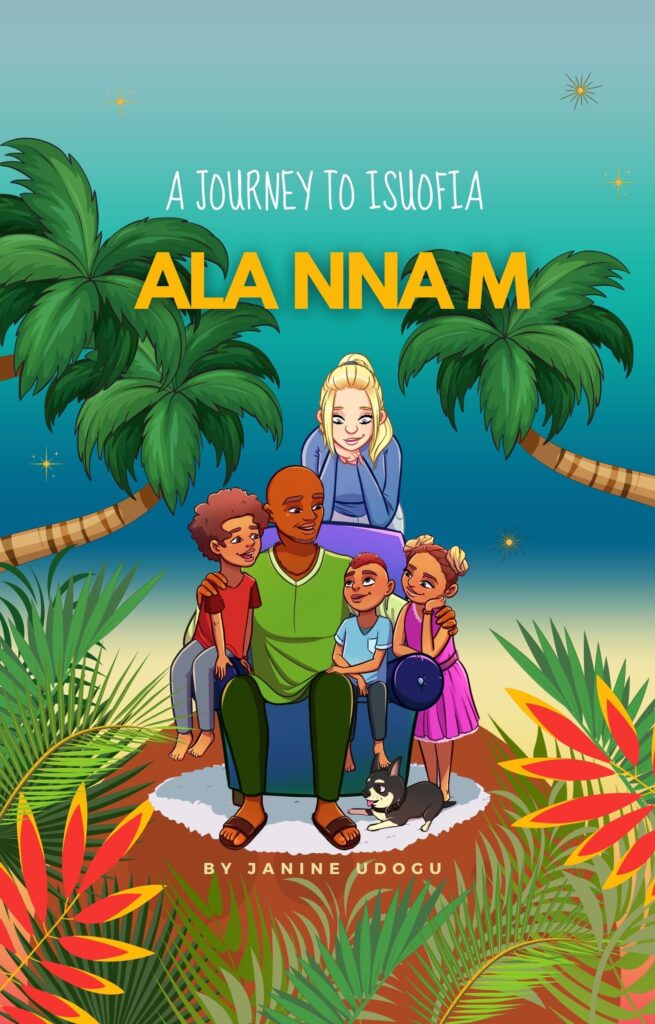
Hello Janine, I’m so happy to be doing this conversation with you. I just realized that we had our first chat on Facebook Messenger like around 2012, like 10 years ago. I think I’m grateful to the Facebook of old (laughs)
Wow, 10 years already. We have really come a long way! Funny enough, we have never met in person. I really hope we can make that happen one day.
So, I was honored to be one of your first readers for your children’s book- and while I was reading, I felt so much nostalgia- like I was interested in how you have decided to take up that project and to do it with a children’s story. What were your motivations to begin this book?
Thank you so much for having me Chimee. I appreciate having you as one of my first readers.
To answer your question, I cannot remember a specific day when I decided to write a children’s book. Rather I felt the urge to share the experience of our children traveling to Isuofia (their father’s village in Anambra State, Nigeria). We have traveled to Nigeria almost every year since the kids were born. So, I have countless adventures to share. Stories about Igbo culture, food, family, and tradition but also about reconnecting, being an outsider, and growing up with two homes. Personally, I feel it is vital for children like ours to be represented in books. There are many stories of white children available in Switzerland and more and more books with stories of Black kids. But I have not yet come across many books that talk of the experience my children are having – being too Black to be white and too white to be Black. Having seen mixed children being lost in this setup, not knowing where they belong or feeling disadvantaged, I think it is my responsibility to help others understand that mixed kids experience the world differently and that it can be amazing and a privilege to grow up in two cultures if only you are ready to embrace it.
You also mentioned that the book was published at the same time you had your last child. How was the process? How long did you you write?
I started writing the book long before I knew I was pregnant. So, the fact that the book was published only a few days before I gave birth was pure coincidence. And while the writing part was easy, everything that followed afterward seemed to delay the project. I was for example, without a doubt, that I wanted a Nigerian Illustrator to draw the images for my book. Someone who could relate to the context and knew about the cultural aspects. However, I did not know how to find the right person. So I used my social media channels to scout illustrators and eventually found the wonderful Charisma Standley. I started sending her my “sketches” and pictures of our family, and she would translate my “ideas” into beautiful illustrations.
Once all the illustrations were ready, I had to do the formatting (which was a total disaster for a beginner like me) and do the translations, before finally publishing the book in Igbo, English, French, German and Spanish.
In your children’s book, you try so well in going down to share what the Igbo family unit and culture looked for children, and especially your children. I know this was coming from your experience constantly visiting South Eastern Nigeria, but do you sometime feel that your knowledge is not enough, or your writing about these topic could have been more intense if you grew up Igbo?
Of course! Even though I have been traveling to Nigeria for the past 14 years, I still discover new aspects of Igbo culture and values every time I visit. The rich cultural traditions, including art, music, dance, and festivals, are overwhelming. And as the Igbo culture is deeply rooted in the community and the extended family, there is so much to learn for me every time I stay with my in-laws. However, I am not convinced that I would know more about the Igbo culture if I grew up Igbo. Because many children nowadays, even those living in Nigeria, are rather disconnected from their forefather’s traditions, culture, and, sadly also the language.
Your children’s book captured topics around culture, race, family, childhood and traveling. I know these are all important to you and are really really important topics generally. Would you say a few things about the interconnectedness of these topics? How did you try to bind them in your children’s book?
The topics you mentioned Chimee are speaking so much to me because they are the topics of my everyday life. Having started a mixed-cultured family, my husband and I get confronted with the differences and similarities of the way we grew up on a daily basis. It can be interesting, fun, stressful, and exhaustive at times, but it is what we signed up for, and we are committed to doing whatever it takes to raise our children to be strong, confident, and rooted in two cultures.
So, for my book, I did not have to bind these topics together intentionally; it is just what our reality looks like every day.
What has happened after the book? How’s the book doing? Are you working on something else?
Well, as you mentioned, I gave birth to my fourth child right before publishing the book, which is why I have been busier being a mom than being an author. But I still managed to do an online book reading at this year’s Lagos Book and Arts Festival, and I hope to get more opportunities to talk about Ala Nnam in the future. Either way, I know that this will not be the last children’s book I publish, so you should better look out for more stories from Isuofia.
You can purchase ALA NNAM through the following:
Ala Nnam – A journey to Isuofia (English Version) Available on Amazon
Ala Nnam – Njem na Isuofia (Igbo Version) Available on Amazon
Or on my website: www.nwanyiocha.ch

